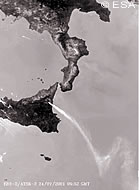ESA satellite monitors Mount Etna
As Europe's most active volcano, Mount Etna in Sicily, Italy threatens to destroy the village of Nicolosi, one of the European Space Agency's (ESA) satellites is carefully monitoring the volcano's activity. Instruments on board ESA's European remote sensing satellite, ERS-2, are monitoring the volcano's movements, temperature and gas emissions. Images from the Global ozone monitoring experiment (GOME) instruments also provide information on trace gas levels in the atmosphere. Data indicates that the level of sulphur dioxide released by the volcano are currently ten times higher than normal. These levels are being found as up to 1000 km away from the volcano. The Along track scanning radiometer (ATSR), also on board ERS-2 , measures the temperature of the Earth's surface, and shows the plume of smoke arising from the volcano's crater. This information is vital for the aviation industry, as volcanic ash can cause engines to stall. Vulcanologists are hoping that, once Envisat, ESA's newest satellite for environment monitoring, is launched later this year, even more data, with increased accuracy will be available for those studying Mount Etna.
Countries
Italy

